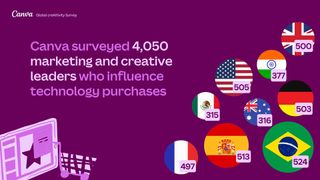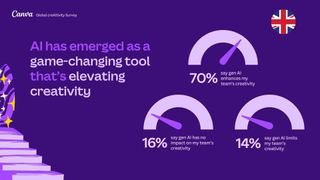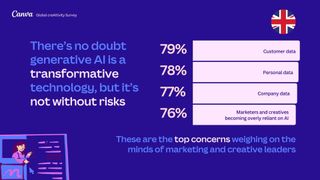The far-reaching impact of AI’s creativity, for creatives
Canva's Europe lead Duncan Clark says AI is enhancing – not replacing – human creativity.

From the iron forge and the printing press to the smartphone, human history has always been shaped by leaps in technology. Breakthrough innovations often amaze us, but only occasionally does a technology come along that is so astonishing that even its inventors are taken aback. Generative AI – which has exploded onto the global scene in the last year – is a rare example.
Even disruptive technologies usually take many years, or even decades, to go from early prototype to global deployment. But generative AI has unlocked unimaginable breakthroughs, unimaginably quickly. In just a few months, things we assumed might always be impossible turned out to be possible, and globally deployable, right now.
Anyone who has had a “conversation” with ChatGPT remembers their first moment of disbelief. Suddenly, computers can do everything from inferring the meaning of data in spreadsheets to perfectly summarising long documents. Even more remarkably, they can also increasingly handle creative tasks, such as writing poems and creating images from scratch – things most of us assumed would always be the unique preserve of humans.
It’s understandable why many people feel unnerved by AI’s foray into our creative arena. But a new survey by Canva shows that – in the real world – generative AI isn’t replacing human creativity. On the contrary, it’s enhancing it.
AI is elevating creativity – and taking care of the chores

The survey interviewed 4000 leaders across the intertwined marketing and creative industries. It found not only that the markets and creatives feel positive about AI, but also that they are adopting it with remarkable speed. Among British respondents, 98% said generative AI is enhancing their team's creativity. And 75% already consider AI as an essential part of their creative process.

Instead of stifling creativity, AI is acting as a catalyst for innovation and the creative process – from brainstorming headlines to experimenting with different image styles. Faced with tight deadlines and shrinking budgets, these tools enable marketers and creatives to generate massive amounts of content quickly and scalably.
Crucially, AI is also liberating creators from day-to-day chores – such as resizing designs for different outputs and copyediting for typos. In the survey, 84% of British creatives and marketers said that AI helps reduce repetitive tasks. With computers handling these mundane tasks, creative minds can channel their energies into more impactful work such as ideation and strategy. The result is a boost in productivity and job satisfaction.
Get the Creative Bloq Newsletter
Daily design news, reviews, how-tos and more, as picked by the editors.
Managing the risks of AI

The integration of artificial intelligence into the creative process has opened up a whole new world of possibilities. But as with all new technologies, there are risks to consider. Among marketers and creatives in the survey, the biggest areas of caution were around AI accessing customer, company and personal data. Interestingly, these outranked the concerns more prominent in the public debate around AI, such as job displacement, plagiarism and bias.
In a sign that organisations are cognisant of the risks, more than 55% of marketing and creative leaders say their company has established strict guidelines for the use of generative AI in the workplace. This number doubtlessly will be rising quickly – and will continue to climb as AI evolves.
While it’s essential to stay abreast of the risks and challenges, seeing how AI is being used across the creative industries gives grounds for optimism. For all the philosophical questions AI raises, the way it’s being used in the real world is quite down to earth. Like so many other technologies before it, AI is reducing the time we need to spend on drudgery, and unlocking new ways of working together – and new ways of being creative.
We see the same in the AI tools we’ve already incorporated into the Canva design platform. Whether our users are designing print materials or preparing boardroom presentations, they feel empowered by AI rather than displaced. The rate of adoption has been extraordinary to see. It’s clear we’re seeing a seismic shift in how technology can enable creativity and design. I can’t wait to see what’s next.
For more on AI image generation, see our pick of the best AI art tutorials.

Thank you for reading 5 articles this month* Join now for unlimited access
Enjoy your first month for just £1 / $1 / €1
*Read 5 free articles per month without a subscription

Join now for unlimited access
Try first month for just £1 / $1 / €1

Duncan Clark is Europe Lead at Canva. He joined Canva as the cofounder of Flourish, the data storytelling platform that became part of the Canva family in 2022. He now oversees data visualisation in the Canva and Flourish products from our campus in London.



